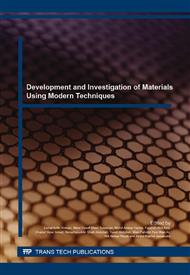[1]
L.B. Møller, C. Halken, J.A. Hansen, J. Bartholdy, Liquid and gas distribution in trickle-bed reactors, Ind. Eng. Chem. Res. 35 (1996) 926–930.
DOI: 10.1021/ie950478p
Google Scholar
[2]
R. Crabtree, U.S. Patent No. 4968651. (1990).
Google Scholar
[3]
J.T. Richardson, D. Remue, J.K. Hung, Properties of ceramic foam catalyst supports: mass and heat transfer, Appl. Catal. A-Gen. 250 (2003) 319–329.
DOI: 10.1016/s0926-860x(03)00287-4
Google Scholar
[4]
UOP LLC 3-37-0: Inert Ceramic Balls (2004).
Google Scholar
[5]
E.M. Ewais, D.H.A. Besisa, Z.I. Zaki, A.E.H.T. Kandil, Tailoring of functionally graded zirconia–mullite/alumina ceramics, J. Eur. Ceram. Soc. 32 (2012) 1561–1573.
DOI: 10.1016/j.jeurceramsoc.2012.01.016
Google Scholar
[6]
B.C. Enger, R. Lødeng, A. Holmen, A review of catalytic partial oxidation of methane to synthesis gas with emphasis on reaction mechanisms over transition metal catalysts, Appl. Catal. A-Gen. 346(1) (2008) 1–27.
DOI: 10.1016/j.apcata.2008.05.018
Google Scholar
[7]
M. Brandhorst, J. Zajac, D.J. Jones, J. Roziere, M. Womes, A.J. Lopez, E.R. Castellon, Appl. Catal. B-Environ. 55 (2005) 267–276.
Google Scholar
[8]
E. Kamseu, C. Leonelli, D.N. Boccaccini, P. Veronesi, P. Miselli, G. Pellacani, U.C. Melo, Characterisation of porcelain compositions using two china clays from Cameroon, J. Ceram. Int. 33(5) (2007) 851–857.
DOI: 10.1016/j.ceramint.2006.01.025
Google Scholar
[9]
N.J. Saikia, D.J. Bharali, P. Sengupta, D. Bordoloi, R.L. Goswamee, P.C. Saikia, P.C. Borthakur, Characterization, beneficiation and utilization of a kaolinite clay from Assam, India, Appl. Clay Sci. 24 (2003) 93–103.
DOI: 10.1016/s0169-1317(03)00151-0
Google Scholar
[10]
K.P. Seong, Sustainable Mining of the Clay Resources in Peninsular Malaysia, Geological Society of Malaysia Bulletin 51 (2005) 1–5.
DOI: 10.7186/bgsm51200501
Google Scholar
[11]
J.M. Amigo, F.J. Serrano, M.A. Kojdecki, J. Bastida,V. Esteve, M.M. Reventos, F. Marti, X-ray diffraction microstructure analysis of mullite, quartz and corundum in porcelain insulators, J. Eur. Ceram. Soc. 25(9) (2005) 1479–1486.
DOI: 10.1016/j.jeurceramsoc.2004.05.019
Google Scholar
[12]
J. Bai, Fabrication and properties of porous mullite ceramics from calcined carbonaceous kaolin and α-Al2O3, Ceram. Int. 36(2) (2010) 673–678.
DOI: 10.1016/j.ceramint.2009.10.006
Google Scholar
[13]
J. Martin-Marquez, J.M. Rincon, M. Romero, Effect of firing temperature on sintering of porcelain stoneware tile, Ceram. Int. 34(8) (2008) 1867–1873.
DOI: 10.1016/j.ceramint.2007.06.006
Google Scholar
[14]
L. Espositoa, A. Salemb, A. Tuccia, A. Gualtieric, S.H. Jazayerid, The use of nepheline-syenite in a body mix for porcelain stoneware tiles, Ceram. Int. 31(2) (2005) 233–240.
DOI: 10.1016/j.ceramint.2004.05.006
Google Scholar


